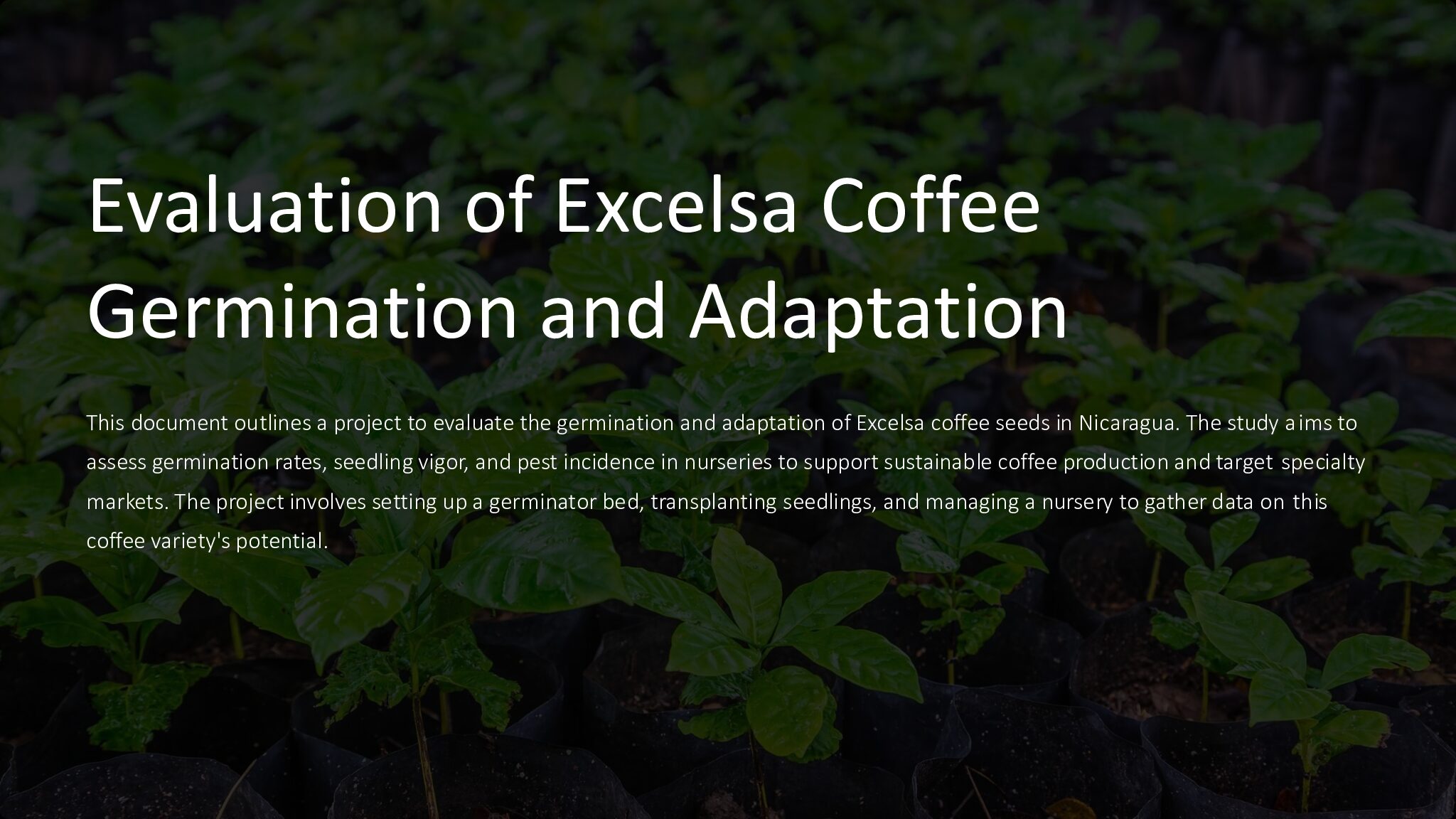Evaluation of Excelsa Coffee Germination and Adaptation: A Study of Seed Viability and Growth in Nicaraguan Nurseries

Introduction
The study of Excelsa coffee germination and adaptation is integral to advancing coffee production in Nicaragua, specifically targeting sustainable and specialty coffee markets. Excelsa coffee, a lesser-known coffee variety, presents unique growth characteristics and potential resilience under specific environmental conditions, making it a viable candidate for Nicaraguan climates and soils. This project evaluates Excelsa coffee’s germination, seedling vigor, and pest resistance, aiming to support small-scale coffee farmers and expand into specialty coffee markets. By establishing a dedicated nursery, researchers obtained crucial data to guide Excelsa coffee’s cultivation, targeting optimal growth conditions and understanding adaptation mechanisms.
Objectives
- Germination Evaluation: The first objective was to assess Excelsa coffee seeds’ germination rate, providing insights into their viability and adaptability.
- Seedling Vigor Assessment: Researchers aimed to evaluate seedling vigor, ensuring the capacity to produce strong, healthy plants for further transplantation.
- Pest Incidence Monitoring: By monitoring pest activity, particularly in nurseries, the project aimed to identify potential risks to young plants and devise suitable management strategies.
Project Rationale and Methodology
Given Nicaragua’s favorable coffee-growing conditions, establishing a nursery for the Excelsa variety provides an opportunity to develop a specialty coffee sector focused on niche markets. The project uses standard nursery practices, including controlled germination, transplanting in containers, and nursery management with rainwater irrigation and fertilizers. Key materials include black polyethylene bags filled with virgin mountain topsoil for transplantation and diammonium phosphate (DAP) for root development. The Excelsa seedlings were transplanted based on strict criteria, with selections favoring seedlings with robust cotyledon leaves and root systems measuring over 9 cm in length.
Nursery Management and Transplantation
The nursery management involved critical practices to support the seedlings’ healthy development:
- Transplantation Setup: Seedlings were transplanted into black polyethylene bags containing 1 kg of virgin mountain soil, creating a nurturing environment for root growth. The bags were placed in 10-meter beds with rows receiving partial shading to ease the transition to direct sunlight. The shading was gradually removed to acclimate the plants, ensuring they could thrive under full light exposure before moving to field settings.
- Irrigation and Fertilization: The nursery relied on rainwater for irrigation, supplementing it with moisture monitoring during dry spells. DAP was applied twice to each plant, delivering essential nutrients to stimulate root growth and overall vigor.
- Pest and Disease Control: A key challenge was managing damping-off disease, a fungal affliction exacerbated by high soil humidity following extended rains. This disease was controlled by reducing shading, allowing more light to reach the plants. Coffee leaf spot, though detected, was minor and posed no significant threat. Continuous monitoring allowed the team to maintain plant health and address any emerging threats promptly.
- Growth Monitoring: By the project’s current stage, seedlings have shown promising growth, with an average height of 16 cm and six leaf pairs, indicating they are ready for field transplantation. Additionally, seedlings displayed healthy root development, averaging 17 cm, which promotes stability and further growth when transferred to field plots.
Results
The study’s findings underline Excelsa coffee’s potential as a viable coffee variety for Nicaraguan agriculture:
- Germination Success: Despite an estimated two-year shelf life for the seed batch, the germination rate reached 89.6%, an impressive outcome indicating the seeds’ resilience and viability. Seeds germinated within an average of 75 days, highlighting their adaptability and capacity to develop under controlled conditions.
- Healthy Root Systems: The seedlings’ root systems were well-established, exhibiting characteristics necessary for successful transplantation and long-term field survival. Notably, scarification of seeds accelerated germination by approximately 15 days, suggesting that this practice may enhance future production.
- Disease Incidence: Disease incidence was low, with damping-off being the primary concern due to high container humidity from frequent rainfall. However, prompt management mitigated its impact. Leaf spot disease appeared but remained insignificant, suggesting Excelsa’s inherent resilience against common nursery diseases.
Conclusions and Recommendations
The project concludes that Excelsa coffee seeds have substantial potential for cultivation in Nicaraguan climates, exhibiting high germination rates, vigorous root development, and minimal disease incidence. The study’s insights into Excelsa’s adaptation underscore its promise as a specialty coffee crop, with the potential to support Nicaragua’s growing coffee industry.
Recommendations for Future Steps:
- Field Evaluation: A dedicated plot should be established for long-term field evaluation to assess the following indicators over the next three to five years:
- Pest incidence and severity to gauge resilience.
- Productive yield for potential economic impact.
- Population density’s effect on growth.
- Cup quality as a measure of marketability.
- Regrowth potential after pruning.
- Labor requirements for harvesting.
- Optimal Transplant Timing: To maximize success, nursery plants should be transplanted by December, utilizing the end of the rainy season for natural irrigation. This timing prevents root entanglement in the bags, which could hinder long-term productivity. Transplanting in May is less ideal, as roots might outgrow the bag, resulting in less productive plants despite vigorous appearances.
- Cost Management Proposal: To sustain the project, it’s essential to include the maintenance, transportation, and transplantation costs in future project proposals. Alternatively, a fixed monthly cost plan can be implemented for nursery management, excluding transportation expenses.
Annexes and Future Research Suggestions
The report includes several annexes documenting the details of seed quality, transplanting criteria, and germination processes, which serve as references for future research and replication efforts. These insights establish a foundational understanding of Excelsa coffee’s potential in diverse settings, from controlled nurseries to open field environments, allowing for further refinement of best practices for sustainable and profitable coffee production in Nicaragua.
Final Thoughts
The study offers valuable insights into Excelsa coffee’s adaptability, resilience, and market potential, laying the groundwork for a specialized sector within Nicaragua’s coffee industry. Excelsa coffee’s success in nurseries suggests its suitability for Nicaragua’s climate and points to the broader benefits of exploring alternative coffee varieties in regions with rich, organic soils. As the project progresses into field evaluation, the results could further reinforce Excelsa coffee’s role in strengthening Nicaragua’s coffee portfolio, paving the way for enhanced income opportunities for small-scale farmers and expanded access to international specialty markets.
Download the full report.
